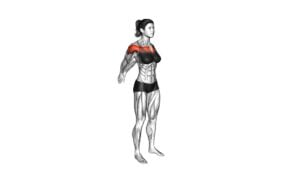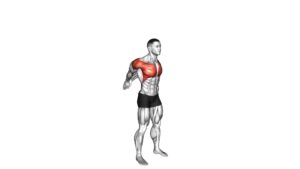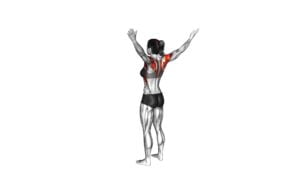Overhead Clap (female) – Video Exercise Guide & Tips

Are you looking for a quick and effective exercise to add to your routine? Look no further than the overhead clap!
Watch This Exercise Video
This simple yet powerful move engages your upper body and core muscles while providing a great cardiovascular workout.
In this video exercise guide, you'll learn proper form and technique, modifications for different fitness levels, and tips for maximizing its effectiveness.
Get ready to take your fitness to new heights with the overhead clap!
Key Takeaways
- The overhead clap targets upper body muscles such as shoulders, arms, and chest.
- Proper form and technique are important to maximize muscle activation and reduce the risk of injury.
- The exercise can be modified for different fitness levels, allowing for progression as strength and fitness improve.
- The overhead clap improves coordination, balance, shoulder mobility, and overall athletic performance.
Benefits of the Overhead Clap
The overhead clap provides a range of benefits for you as a female exerciser. This exercise targets your upper body, specifically your shoulders, arms, and chest, helping to strengthen and tone these areas. The best part is, you don't need any equipment to perform the overhead clap. It can be done anywhere, anytime, making it a convenient option for incorporating into your workout routine.
There are different variations of the overhead clap that you can try to keep your workouts interesting and challenge your muscles in different ways. One variation is the single-arm overhead clap, where you alternate clapping one hand overhead while keeping the other hand stationary. Another variation is the double-arm overhead clap, where you clap both hands overhead simultaneously.
By incorporating the overhead clap into your workout routine, you can improve your upper body strength, enhance shoulder stability, and increase your range of motion. It's also a great exercise for improving coordination and balance.
Now that you know the benefits of the overhead clap, let's move on to discussing proper form and technique to ensure you get the most out of this exercise.
Proper Form and Technique
To perform the Overhead Clap with proper form and technique, it's important to maintain correct body alignment throughout the exercise.
This means standing tall with your feet shoulder-width apart, engaging your core, and keeping your shoulders back and down.
Avoid common mistakes such as hunching your shoulders or bending your arms too much.
Correct Body Alignment
Ensure proper body alignment by frequently checking your form and technique during the overhead clap exercise. Proper body alignment is crucial to maximize the effectiveness of the exercise and prevent injuries. Here are four key points to consider:
- Stand with your feet shoulder-width apart and your knees slightly bent. This will provide a stable base for the exercise.
- Engage your core muscles by pulling your belly button towards your spine. This will help maintain a neutral spine and protect your lower back.
- Keep your shoulders relaxed and down, away from your ears. Avoid rounding your shoulders or arching your back.
- Extend your arms fully overhead, making sure to keep them in line with your ears. This will ensure proper alignment and engage your upper body muscles effectively.
Avoiding Common Mistakes
Maintain proper form and technique to avoid common mistakes during the overhead clap exercise. By doing so, you can minimize the risk of injury and improve your coordination.
When performing the overhead clap, it's important to keep your core engaged and your back straight. Avoid leaning forward or backward, as this can strain your lower back.
Additionally, make sure to fully extend your arms overhead and clap your hands together with control, rather than forcefully slamming them together. This will help prevent wrist or shoulder injuries.
Benefits of Proper Technique
Improve your workout results and reduce the risk of injury by using proper form and technique during the overhead clap exercise. Here are the benefits of performing the overhead clap with proper technique:
- Maximizing results: When you use proper form, you engage the targeted muscles effectively, leading to better muscle activation and growth. This helps you achieve your fitness goals more efficiently.
- Preventing injury: Proper technique ensures that you maintain proper alignment and avoid placing unnecessary stress on your joints. This reduces the risk of strains, sprains, and other injuries.
- Targeting specific goals: By varying the speed and intensity of your overhead claps, you can tailor the exercise to meet specific goals. Slow and controlled claps build strength, while faster claps improve cardiovascular endurance.
- Increasing flexibility: Executing the overhead clap with proper form helps improve shoulder mobility and flexibility, enhancing overall athletic performance.
Modifications for Different Fitness Levels
To accommodate various fitness levels, modify the overhead clap exercise by adjusting the speed and intensity of the movement. There are different modifications and fitness progressions you can try based on your current fitness level.
For beginners or those with lower fitness levels, start by performing the overhead clap exercise at a slower pace. This allows you to focus on proper form and technique while gradually building strength and endurance. As you become more comfortable with the exercise, you can gradually increase the speed of the clap to add more intensity.
If you have a moderate fitness level, you can perform the overhead clap exercise at a moderate pace. This challenges your muscles and cardiovascular system, helping you to improve your overall fitness. You can also try incorporating light weights into the exercise to further enhance the intensity.
Advanced fitness levels can benefit from performing the overhead clap exercise at a fast pace. This requires a higher level of strength, coordination, and cardiovascular fitness. You can also increase the intensity by using heavier weights or incorporating variations such as jumping while performing the clap.
By modifying the speed and intensity of the overhead clap exercise, you can tailor it to your individual fitness level and gradually progress as you become fitter and stronger.
Now, let's move on to the next section and discuss some common mistakes to avoid.
Common Mistakes to Avoid
When performing the overhead clap exercise, it's important to be aware of common mistakes that can hinder your progress and potentially lead to injury. Here are some tips for avoiding these common mistakes:
- Improper form: One of the most common mistakes is failing to maintain proper form throughout the exercise. To avoid this, make sure to keep your back straight, your core engaged, and your shoulders relaxed. Avoid arching your back or hunching your shoulders.
- Using too much weight: Another mistake is using weights that are too heavy for your fitness level. This can put unnecessary strain on your muscles and joints. Start with lighter weights and gradually increase the resistance as you become stronger and more comfortable with the exercise.
- Relying on momentum: It's important to perform the overhead clap exercise with controlled movements instead of relying on momentum. Avoid swinging your arms or using a jerking motion to lift the weights. Focus on engaging your muscles and performing each repetition with control.
- Neglecting warm-up and cool-down: Skipping the warm-up and cool-down can increase the risk of injury. Before starting the exercise, take a few minutes to warm up your muscles with light cardio or dynamic stretches. After the workout, cool down with static stretches to help prevent muscle soreness.
Tips for Maximizing the Overhead Clap's Effectiveness
To maximize the effectiveness of the overhead clap, there are a few tips you should keep in mind.
First, focus on maintaining proper form throughout the exercise. This means keeping your core engaged, shoulders back, and arms fully extended overhead.
Proper Form Techniques
Maximize the effectiveness of your overhead clap by focusing on proper form techniques. To ensure you get the most out of this exercise, here are some tips to keep in mind:
- Maintain a straight posture: Stand tall with your feet shoulder-width apart and engage your core muscles to stabilize your body.
- Keep your arms fully extended: Throughout the movement, make sure your arms are straight and reach as high as possible overhead.
- Squeeze your shoulder blades: As you bring your arms down, actively squeeze your shoulder blades together to engage your upper back muscles.
- Control the movement: Avoid swinging your arms or using momentum. Instead, use controlled and deliberate motions to maximize the effectiveness of the exercise.
By following these proper form techniques, you can prevent common mistakes and ensure that beginners can easily modify this exercise.
Now, let's explore the muscle groups targeted by the overhead clap.
Muscle Groups Targeted
To target and maximize the effectiveness of the overhead clap, focus on engaging specific muscle groups by maintaining proper form techniques.
The overhead clap primarily activates the deltoids, which are responsible for shoulder flexion and abduction. Additionally, the trapezius muscles in your upper back and the pectoralis major muscles in your chest are also engaged during this exercise.
To ensure proper muscle activation, keep your core engaged and your spine straight throughout the movement.
For variations and modifications, you can use different weights or resistance bands to increase the intensity. You can also try performing the overhead clap while standing on one leg to challenge your balance and activate your core muscles even more.
Now, let's move on to a sample workout routine incorporating the overhead clap.
Sample Workout Routine Incorporating the Overhead Clap
Incorporate the overhead clap into your workout routine for an effective upper body exercise. This exercise targets your shoulders, chest, and arms while also engaging your core muscles.
Here's a sample workout routine that incorporates the overhead clap:
- Warm-up: Start with a five-minute cardio warm-up, such as jogging or jumping jacks, to prepare your body for exercise.
- Overhead Clap: Stand with your feet shoulder-width apart and extend your arms out to the sides at shoulder height. Clap your hands together overhead, then quickly return to the starting position. Repeat for 10-12 reps.
- Push-ups: Get into a high plank position with your hands shoulder-width apart. Lower your body towards the floor, keeping your elbows close to your sides, then push back up. Aim for 2 sets of 10-12 reps.
- Dumbbell Shoulder Press: Hold a dumbbell in each hand at shoulder level. Push the weights up overhead, fully extending your arms, then lower them back down. Perform 3 sets of 8-10 reps.
Remember to modify the intensity of the exercises based on your fitness level and listen to your body. Incorporate these variations of the overhead clap into your routine to add variety and challenge to your upper body workouts.
Frequently Asked Questions
How Many Calories Can You Burn by Doing the Overhead Clap Exercise?
You can burn calories and achieve numerous benefits by doing the overhead clap exercise. It's an effective cardio workout that engages your upper body muscles, including your shoulders, arms, and chest.
By raising your arms overhead and clapping your hands together, you increase your heart rate and burn calories. This exercise also helps improve your coordination and posture.
Incorporate the overhead clap into your fitness routine for a fun and effective calorie-burning workout.
Can the Overhead Clap Exercise Help in Toning the Arms?
The overhead clap exercise is an effective way to tone your arms. By performing this exercise, you can strengthen and define the muscles in your arms, including the biceps and triceps. The overhead clap also works the shoulders, chest, and upper back, providing overall body strength and flexibility.
To perform it correctly, stand with your feet shoulder-width apart and raise your arms overhead, clapping your hands together.
Incorporate the overhead clap exercise into a full body workout routine for maximum results.
Is It Necessary to Warm up Before Performing the Overhead Clap Exercise?
Before performing the overhead clap exercise, it's necessary for you to warm up. Warming up has many benefits, such as increasing blood flow to your muscles and reducing the risk of injury.
To properly perform the overhead clap, stand with your feet shoulder-width apart and extend your arms overhead. Clap your hands together forcefully while keeping your core engaged. Remember to maintain proper form and technique throughout the exercise to maximize its effectiveness.
Can the Overhead Clap Exercise Be Done With Weights for Added Resistance?
Yes, you can definitely perform the overhead clap exercise with weights for added resistance. Using dumbbells during the overhead clap can provide several benefits.
The weights increase the intensity of the exercise, helping to strengthen your shoulder muscles and improve upper body strength.
Additionally, the added resistance challenges your muscles, helping to enhance muscle growth and definition.
However, it's important to start with lighter weights and gradually increase the load to avoid injury and ensure proper form.
Are There Any Alternative Exercises That Target the Same Muscle Groups as the Overhead Clap?
If you're looking for alternative exercises that target the same muscle groups as the overhead clap, there are a few options to consider.
One option is the lateral raise, which focuses on the shoulders and upper back.
Another alternative is the front raise, which targets the front deltoids.
Additionally, the bent-over lateral raise can help strengthen the rear delts.
These exercises can be great alternatives if you're looking for variety in your workout routine.
Conclusion
In conclusion, the overhead clap is a great exercise for improving upper body strength and coordination. By following proper form and technique, and making modifications as needed, individuals of all fitness levels can benefit from this exercise.
It's important to avoid common mistakes and to maximize the effectiveness of the overhead clap by incorporating it into a well-rounded workout routine.
So give it a try and reap the rewards of this simple yet effective exercise.

Author
Years ago, the spark of my life’s passion ignited in my mind the moment I stepped into the local gym for the first time. The inaugural bead of perspiration, the initial endeavor, the very first surge of endorphins, and a sense of pride that washed over me post-workout marked the beginning of my deep-seated interest in strength sports, fitness, and sports nutrition. This very curiosity blossomed rapidly into a profound fascination, propelling me to earn a Master’s degree in Physical Education from the Academy of Physical Education in Krakow, followed by a Sports Manager diploma from the Jagiellonian University. My journey of growth led me to gain more specialized qualifications, such as being a certified personal trainer with a focus on sports dietetics, a lifeguard, and an instructor for wellness and corrective gymnastics. Theoretical knowledge paired seamlessly with practical experience, reinforcing my belief that the transformation of individuals under my guidance was also a reflection of my personal growth. This belief holds true even today. Each day, I strive to push the boundaries and explore new realms. These realms gently elevate me to greater heights. The unique combination of passion for my field and the continuous quest for growth fuels my drive to break new ground.







